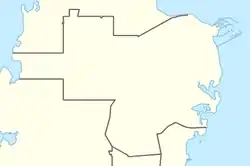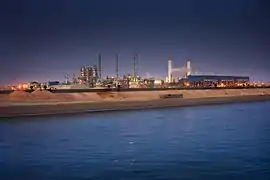Al Khor
Al Khor (Arabic: الخور; also spelled Al Khawr), officially Al Khor and Al Thakhira, is a municipality in the State of Qatar. Al Khor City, the municipal seat, is located in the northeast coast of Qatar, around 50 kilometres (31 miles) from the capital, Doha and it is considered to be one of the major cities in Qatar.[2] Al Thakhira is the second largest settlement in the municipality after Al Khor City.
AL khor
الخور | |
|---|---|
.JPG.webp) View of harbor in Al Khor City | |
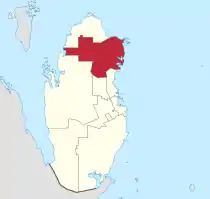 Map of Qatar with Al Khor highlighted | |
| Coordinates (Al Khor City): 25.69°N 51.51°E | |
| Country | |
| Capital | Al Khor City |
| Zones | 3 |
| Government | |
| • Mayor | Ibrahim Issa Nasser Al Fadalah |
| Area | |
| • Total | 1,613.3 km2 (622.9 sq mi) |
| Population (2015)[1] | |
| • Total | 202,031 |
| • Density | 130/km2 (320/sq mi) |
| Time zone | UTC+03 (East Africa Time) |
| ISO 3166 code | QA-KH |
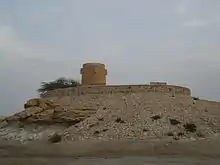
The region was ruled by the Al Muhannadi tribe, which consists of seven Bedouin families, before Qatar gained its independence in 1971. Tourism has been increasing in recent years owing to the municipality's various resorts, natural areas and cultural attractions. Fishing was the historical mainstay of most of the municipality's inhabitants.
Etymology
Al Khor Municipality derives its name from the city of the same name. In Arabic, Al Khawr means bay; it was so named because Al Khor City was near a bay. Formerly, the city was known as "Khor Al-Shaqiq".[3]
History
Al Khor Municipality was established in July 1972, alongside Qatar's four other initial municipalities, and supervises the city of Al Khor in addition to other settlements in the municipality.[4] As of 2017, Ibrahim Issa Nasser Al Fadalah is the mayor of the municipality.[5]
Municipal seat
Al Khor City, the municipal seat, is a coastal city located 57 kilometres (35 miles) north of the capital Doha, 47 km away from Madinat ash Shamal, and 44 km away from Al Wakrah.[6] In the past, it was well known for the role it played in Qatar's bustling pearling industry, as well as for its harbour which is filled with fishing boats and small crafts. Several beaches, renovated forts and cultural attractions are found in the city.[7]
Geography
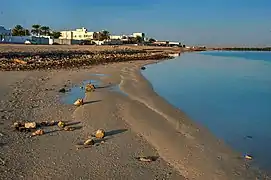
Al Khor is situated in northern Qatar, bordered by the municipalities of Al Shamal to the north, Al Daayen and Umm Salal to the southeast, and Al-Shahaniya to the southwest. In addition to the main municipal headquarters in Al Khor City, there are Ministry of Municipality and Environment branches in Al Thakhira and Al Ghuwariyah.[8]
Much of Al Khor's territory lies along the Qatari Peninsula's eastern coast, including the eastern boundaries of municipality's two main cities – Al Khor City and Al Thakhira. Numerous beaches are located in this area, including Al-Farka Beach in Al Khor City and Al Thakhira Beach.[9] A seafront promenade stretched over a 28,000 square meter area known as Al Khor Corniche runs through the municipal seat.[10]

According to the Ministry of Municipality and Environment, the municipality accommodates 170 rawdas, 49 wadis, 57 jeris (places where water flows), seven jeryan (multiple jeris), seven plains, 22 hills, five highlands, 13 sabkhas, 17 capes, four bays, and three coral reefs. Four islands are found off its shores, the most important of which is Al Khor Island (also known as Jazirat Bin Ghanim).[11]
White mangrove forests in Qatar can be found in greatest abundance near Al Khor and Al Thakhira. This species of mangroves is well-adapted to the saline conditions of the northeast coast.[12] A minimum of eight mangrove sites exist in Qatar, and all are protected areas as of a 2006 Emiri decree.[13]
Climate
The following is climate data for the municipal seat, Al Khor.
| Climate data for Al Khor City | |||||||||||||
|---|---|---|---|---|---|---|---|---|---|---|---|---|---|
| Month | Jan | Feb | Mar | Apr | May | Jun | Jul | Aug | Sep | Oct | Nov | Dec | Year |
| Average high °C (°F) | 20.5 (68.9) |
22.5 (72.5) |
27 (81) |
32.5 (90.5) |
39 (102) |
41.5 (106.7) |
42 (108) |
40.5 (104.9) |
39 (102) |
35 (95) |
29 (84) |
23 (73) |
32.6 (90.7) |
| Average low °C (°F) | 12 (54) |
13.5 (56.3) |
16 (61) |
21 (70) |
25 (77) |
26.5 (79.7) |
28.5 (83.3) |
27.5 (81.5) |
26 (79) |
23.5 (74.3) |
20 (68) |
14 (57) |
21.1 (70.1) |
| Average precipitation mm (inches) | 11 (0.4) |
1.5 (0.06) |
2 (0.1) |
6.5 (0.26) |
1 (0.0) |
0 (0) |
0 (0) |
0 (0) |
0 (0) |
0.25 (0.01) |
13.5 (0.53) |
22 (0.9) |
57.75 (2.26) |
| Average relative humidity (%) | 61 | 60 | 56 | 53 | 49 | 50 | 51 | 57 | 60 | 63 | 69 | 74 | 59 |
| Source: Qatar Statistics Authority[14] | |||||||||||||
Administration
The municipality is divided into 3 zones which are then divided into 454 blocks.[15] Two of its main districts, Simaisma and Al Jeryan, are geographically located in Al Daayen. Additionally, the village of Madinat Al Kaaban is geographically located in Al Khor but serves as an administrative district for Al Shamal.[3]
Administrative zones
The following administrative zones are found in Al Khor Municipality as of 2015:[1]
| Zone no. | Settlements | Area (km2) | Population (2015) |
|---|---|---|---|
| 74 | Simaisma Al Jeryan Al Khor City | 373.9 | 96,169 |
| 75 | Al Thakhira Ras Laffan Umm Birka | 610.8 | 100,118 |
| 76 | Al Ghuwariyah | 628.6 | 5,744 |
| Municipality | 1613.3 | 202,031 | |
Districts
Other settlements in Al Khor include:[17]
- Abu Al Qararis (Arabic: ابا القراريص)
- Al Egda (Arabic: العقدة)
- Al Heedan (Arabic: الحيضان)
- Al Khor Industrial Area (Arabic: صناعية الخور)
- Al Khor Island (Arabic: جزيرة الخور; also Jazirat bin Ghannam)
- Al Rashida (Arabic: رشيدة)
- Al Waab (Arabic: الوعب)
- Ras Matbakh (Arabic: راس مطبخ)
- Rawdat Al Faras (Arabic: روضة الفرس)
- Rawdat Bakheela (Arabic: روضة بخيلة)
- Umm Al Hawaya (Arabic: ام الحوايا)
- Umm Al Maa (Arabic: ام الماء)
- Umm Al Qahab (Arabic: ام القهاب)
- Umm Anaig (Arabic: ام عنيق)
- Umm Ethnaitain (Arabic: ام اثنيتين)
- Wadi Al Harm (Arabic: وادي الهرم)
- Waab Al Mashrab (Arabic: وعب المشرب)
Education
Public schools in Al Khor amounted to 21 as recorded in the 2016 education census – 11 were exclusively for girls and 10 were for boys. A higher number of students were female, at 2,192 compared to 1,703 male students.[18]
The first school outside of Doha was opened in the city of Al Khor in 1952.[19] Al Khor International School, located in Al Khor Community (also known as Umm Enaig), is one of the largest schools in the municipality, accommodating 4,000 students of families employed by RasGas and Qatargas.[20]
Healthcare
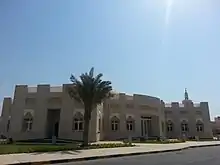
The 2015 government census indicated that there are 9 healthcare facilities registered in the municipality.[21] Residents near Al Khor City are currently served by Al Khor General Hospital, which is under the auspices of Hamad Medical Corporation. It has a bed capacity of 115 and was opened in 2005. Health services provided by the hospital include general medical care, general surgery, obstetrics, pediatrics and neonatal care.[22]
Eight pharmacies were recorded in the municipality in 2013 by Qatar's Supreme Council of Health.[23]
Culture

Located in a former two-level police station along the coast in Al Khor City is the Al Khor Archaeological Museum. It houses artifacts collected from expeditions carried out in the municipality.[24] On the ground floor of the museum, handiwork relating to Qatar's cultural heritage are on display, and there are exhibits on the maritime traditions historically engaged in by Qataris, such as fishing and shipbuilding. Ancient artifacts obtained from excavations, including those done on the dye industry in Al Khor Island, are hosted on the first floor, as well as geographic maps of Al Khor. On the second level, visitors are provided with a view of the bay and docks near the museum.[25]
%252C_seafront.JPG.webp)
Al-Khor SC is active in organizing social events through its cultural division, the Al Khor SC Social and Cultural Committee. A number of partnerships have been signed between the committee and local schools and organizations. The committee is responsible for organizing the Al-Khor SC's summer camps which include educational lectures and physical activities.[26] Programs put into effect by the committee include the Midar Maritime Festival at Al Khor Port, the Phantom Jets Championship in January 2015 at Al Khor Airport, diving classes, and natural history tours of various archaeological sites in the country.[27]
Al Khor Mall is an important cultural venue. It accommodates the first three cinemas to be constructed in the municipality, with a combined capacity of 600 viewers.[28] As part of Qatar's annual Eid Al Fitr Festival, theatrical performances take place in the mall.[29]
Economy
Natural gas
In the 1970s, natural gas was discovered off of Qatar's east coast in an area that came to be known as the North Field. The north-east portion of the municipality, known as Ras Laffan, was converted to a natural gas processing center.[30] At present, Ras Laffan accommodates the world's largest GTL plant,[31] the Pearl GTL which was constructed as by a partnership between Royal Dutch Shell and Qatar Petroleum.[32] Qatar is also the world's second largest supplier of helium, which can bextracted from natural gas.[33] All of the country's helium is produced by RasGas's two helium plants in Ras Laffan, which were commissioned in 2005 and 2013, respectively.[34] In June 2017, amidst the Qatar diplomatic crisis, the government ordered the two plants to be shut down indefinitely.[33]
Agriculture
Agricultural activities such as fishing and pearling were traditional mainstays of the inhabitants of this region.[35] Despite being overtaken in importance by the extraction and construction industries, agriculture is still one of the largest industries in Al Khor. Domestically, 35% of Qatar's total farmland was based in Al Khor in 2015, putting it just behind the municipality of Al Rayyan which had a 36% share of Qatar's farmland. Al Khor, however, had the highest density of farms. There were 344 farms spread out over 16,943 hectares, most of which (220) were mixed operations, 119 of which were occupied solely by crops, and 3 of which livestock were reared on.[36] The municipality had a livestock inventory of 160,675, the majority of which were sheep (109,337). Livestock numbers surpassed that of all other municipalities.[37] Root vegetables such as carrots, potatoes, onions and fodder beets are some of the most important crops produced by Qatari farms,[38] the latter of which is grown in large quantities at Al Dawoodiyah in Al Khor.[39]
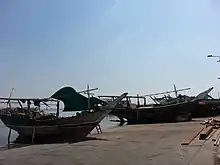
In terms of artisanal fishing vessels, Al Khor had the highest amount out of any city surveyed in 2015 at 234 vessels. The city also had the most sailors (1,408) and was also the only major city to record an increase in the rate of sailors from 2010 to 2015.[40]
After Qatar was embargoed by a quartet composed of Saudi Arabia, the United Arab Emirates, Bahrain and Egypt in June 2017, it launched a project to fly over 10,000 cows to Qatar in order to reach its goal of food self-sufficiency.[41] This project will be based on a two-million square meter plot owned by Baladna in the Umm Al Hawaya locality of the municipality.[42]
One of the most important agricultural research stations in Qatar is located in Rawdat Al Faras. The research station, established in 1976,[43] consists of a laboratory, a warehouse and five palm tree fields hosting thousands of palm trees.[44]
Capitalizing on the municipality's rich maritime tradition, the 101,000 square meter facility of the Aquatic Fisheries and Research Centre was completed in Ras Matbakh by Ashghal in 2017 at a cost of QR 237.7 million.[45]
Three major government-owned plant nurseries are located in Al Khor; two are in the village of Al Rashida, and there is one in Rawdat Bakheela. Plants grown in these nurseries are used for research and also distributed to government ministries. The nurseries in Al Rashida each span 2,500 square meters and were established in 2003.[46] A farmers' market is found in Al Khor Yard.[47]
Housing
Al Khor's municipal council announced plans to open two workers' cities in the Abu Al Qararis area in 2016. These cities are planned to facilitate 45,000 inhabitants.[48]
.JPG.webp)
Barwa Group carries out real estate projects in Al Khor through its subsidiary, Barwa Al Khor. In November 2008, the group unveiled its major 'Urjuan' project, which had a projected cost of $10 billion. Located near the city of Al Khor, Urjuan was described as a planned city capable of hosting 63,000 inhabitants spread over 5.5 million square km. The project had a planned completion date of 2013 and its plots were to be sold through several phases.[49] However, in December 2009, the project was indefinitely put on hold.[50]
Shell Project, a real estate project featuring 350 housing units, a supermarket, and a mosque spanning an area of 138,000 square meters, was completed by Barwa Al Khor in 2016 and its ownership transferred to Royal Dutch Shell.[51]
Al Khor Community constitutes the biggest housing community in the country at about 15,000 residents. Located in Umm Enaig near Al Thakhira, it hosts 15,000 people and has well-developed infrastructure, including a medical center, five sports facilities, a library, schools, a skate park and playgrounds.[52]
Transport
.JPG.webp)
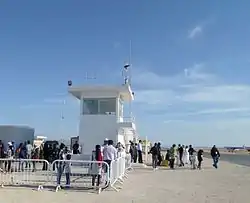
Roads
Turkish company Tekfen was contracted to construct the $2.1 billion Al Khor Expressway in August 2016.[53] The expressway is designed to be 34 kilometres (21 miles) in length and will run from Doha Golf Club in Al Egla, a locality of Al Daayen, up to Al Bayt Stadium in Al Khor City. A designated bicycle lane and ten interchanges are to be incorporated as part of the project.[54]
Commutes between the capital Doha and the municipality of Al Khor are currently facilitated by Al Shamal Road and Al Khor Coastal Road, with the latter road running through Al Daayen and the former running through Umm Salal.[55]
Air
Aviation traffic is controlled by Al Khor Airport in Al Khor City. The airport is mostly used by general aviation aircraft and has served as the venue of the annual Al Khor Fly-In since 2008. The fly-in lasts for two days and allows visitors to travel in and spectate aircraft. Aircraft from other GCC countries are showcased at the event.[56]
Rail
The Doha Metro's Red Line (also known as Coast Line) will extend to Al Khor. Red Line is separated into two divisions: Red Line North and Red Line South. The former will run from Mushayrib Station to Al Khor City, over a length of 55.7 kilometres (34.6 miles).[57]
Sports
The municipality is represented by the sports club Al-Khor SC, which play in Al-Khor SC Stadium in the municipality's capital city. Al Bayt Stadium, also in Al Khor City, is planned to be completed by the 2022 FIFA World Cup. Al Bayt Stadium, which translates to 'the house', is designed to replicate a traditional tent used by Qatari nomads. The seating capacity will be 60,000 spectators and it is set to host one of the semi-finals.[58]
Al Thakhira has its own amateur football league. In 2005, Al Thakhira FC was formed and has competed in the QFA-sanctioned Qatar Amateur League since 2013.[59]
Barwa Al Khor formally opened Al Khor Workers Sports Complex in the Al Khor Industrial Area in February 2014.[60] Intended to serve the entire municipality of Al Khor as well as portions of Al Shamal Municipality, the sporting facilities within this massive complex include four cricket fields, four football fields, four basketball courts and three volleyball courts. In addition, there are 35 shops, 2 cinemas and a mosque among its facilities. In 2015, over 500,000 people had visited the complex.[61]
Visitor attractions
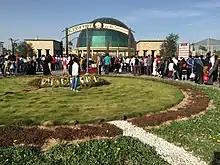
According to the Ministry of Municipality and Environment, the municipality hosts 7 parks as of 2018.[62] Al Khor City has the largest park in the municipality - Al Khor Park with an area of 240,000 square meters. Starting in June 2010, the government has invested QR 250 million in refurbishing the park.[63] This has resulted in the development of new facilities in the park such as a mini-golf course, a railway station and a museum.[64] Al Thakhira also has a major park, opened in 2009 and covering an area of 14,580 square meters.[65] Al Ghuwariyah opened its own park in 2017 over an area of 9,234 square meters.[66]
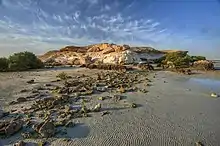
Al Khor Island (commonly known as Purple Island) is located near Al Khor City. Considered to be a domestic ecoturism destination, the island is connected to the mainland by a tapered dirt path which runs through a number of streams.[67] Aside from its scenic landscape, the island is also known for its historical role in the Kassite dyeing industry dating back several thousand years.[68]
Demographics
The following table is a breakdown of registered live births by nationality and sex for Al Khor. Places of birth are based on the home municipality of the mother at birth.[69]
|
| ||||||||||||||||||||||||||||||||||||||||||||||||||||||||||||||||||||||||||||||||||||||||||||||||||||||||||||||||||||||||||||||||||||||||||||||||||||||||||||||||||||||||||||||||||||||||||||||||||||||||||||||||||||||||||||||||||||||||||||||||||||||||||||||||||||||||||||||||||||||||||||||||||||||||||||||||||||||||||||||||
References
- "2015 Population census" (PDF). Ministry of Development Planning and Statistics. April 2015. Retrieved 8 August 2017.
- "Archived copy". Archived from the original on 3 September 2011. Retrieved 9 September 2011.CS1 maint: archived copy as title (link)
- "District map". The Centre for Geographic Information Systems of Qatar. Retrieved 23 May 2018.
- "Al Khor & Dhekra Municipality". Ministry of Municipality and Environment. Retrieved 23 May 2018.
- "تعيين 112 مديراً ورئيساً لقسم ومكتب في 8 بلديات" (in Arabic). Al Sharq. 21 April 2017. Retrieved 8 August 2017.
- "Qatar in Figures" (PDF). Ministry of Development Planning and Statistics. 2015. p. 9. Retrieved 8 July 2018.
- "The Dye is Cast". whyqatar.me. 4 March 2013. Archived from the original on 25 June 2018. Retrieved 25 June 2018.
- "المكاتب الفرعية التابعة للخور" (in Arabic). Ministry of Municipality and Environment. Retrieved 8 July 2018.
- "خريطة توضيحية لمواقع الشواطئ العائلية الجديدة" (in Arabic). Ministry of Municipality and Environment. 2 August 2012. Retrieved 8 July 2018.
- "Opening Al Khor Corniche Development Project before the beginning of Ramadan". Ashghal. 14 May 2018. Retrieved 10 July 2018.
- "Geonames Sortable Table". arcgis.com. Geographic Information Systems Department (Qatar). Retrieved 13 February 2019.
- Hend Khader (13 October 2015). "Mangroves in Qatar: Perspectives". ECOMena. Retrieved 8 July 2018.
- Lesley Walker (13 May 2014). "Volunteers needed for Al Thakira mangroves clean-up". Doha News. Retrieved 8 July 2018.
- "Temperature/Humidity/Rainfall". Qatar Statistics Authority. Archived from the original on 22 March 2013. Retrieved 24 June 2018.
- "Administrative boundary map". Ministry of Development Planning and Statistics. Retrieved 9 July 2018.
- "District map". The Centre for Geographic Information Systems of Qatar. Retrieved 25 May 2018.
- "Qatar Development Atlas - Part 1" (PDF). Ministry of Development Planning and Statistics. 2010. p. 10. Retrieved 10 July 2018.
- "Chapter IV: Education Statistics" (PDF). Ministry of Development Planning and Statistics. 2016. Retrieved 10 July 2018.
- Abdulla Juma Kobaisi (1979). "The Development of Education in Qatar, 1950–1970" (PDF). Durham University. p. 38. Retrieved 23 May 2018.
- Lesley Walker (23 October 2015). "Five reasons you should consider moving to northern Qatar's Al Khor". Doha News. Retrieved 23 May 2018.
- "The Simplified Census of Population, Housing & Establishments 2015" (PDF). Ministry of Municipality and Environment. April 2015. pp. 65–66. Retrieved 8 August 2017.
- "Al Khor Hospital (About)". Hamad Medical Corporation. Retrieved 23 May 2018.
- "Qatar Healthcare Facilities: Master Plan 2013-2033" (PDF). Supreme Council of Health (Qatar). September 2014. p. 107. Retrieved 9 July 2018.
- Whelan, John (1983). Qatar, a MEED practical guide. London: Middle East Economic Digest. p. 159. ISBN 0950521191.
- "Al Khor museum". Explore Qatar. Retrieved 12 July 2018.
- "Al Khor SC in the community". Al Khor SC. Retrieved 12 July 2018.
- "Report 2014-2015" (PDF). Al Khor SC. Retrieved 12 July 2018.
- "Al Khor's first cinemas to open on Eid al-Adha". Qatar is Booming. 30 July 2015. Retrieved 12 July 2018.
- "Eid Festival begins today". Qatar Tribune. 17 July 2015. Archived from the original on 13 July 2018. Retrieved 12 July 2018.
- Stanley Reed (5 August 2015). "Liquefied Natural Gas Makes Qatar an Energy Giant". The New York Times. Retrieved 12 July 2018.
- "Shell's Pearl GTL plant running at reduced production". Hydrocarbon Processing. 23 December 2016. Retrieved 12 July 2018.
- "Pearl GTL - overview". Royal Dutch Shell. Retrieved 12 July 2018.
- "UPDATE 1-Qatar closes helium plants amid rift with Arab powers". Reuters. 13 June 2017. Retrieved 12 July 2018.
- "Subsidiaries and Joint Ventures". Qatar Petroleum. Retrieved 12 July 2018.
- "10 Qatar heritage sites". TimeOut Doha. 6 April 2015. Retrieved 12 July 2018.
- "Environmental statistics in State of Qatar" (PDF). Ministry of Development Planning and Statistics. 2015. p. 30. Retrieved 12 July 2018.
- "Environmental statistics in State of Qatar" (PDF). Ministry of Development Planning and Statistics. 2015. p. 38. Retrieved 12 July 2018.
- "Agriculture and Fisheries". Qatar e-Government. Retrieved 18 July 2018.
- "مزرعة قطرية تنتج أحجاما عملاقة من البنجر" (in Arabic). Al Raya. 23 January 2007. Retrieved 17 July 2018.
- "Environmental statistics in State of Qatar" (PDF). Ministry of Development Planning and Statistics. 2015. pp. 84–85. Retrieved 12 July 2018.
- Patrick Wintour (20 October 2017). "Land of milk and money: Qatar looks to farms to beat the Gulf boycott". The Guardian. Retrieved 23 May 2018.
- "Baladna Farm". UrbaCon Trading & Contracting. Archived from the original on 24 May 2018. Retrieved 23 May 2018.
- "وفود دول مجلس التعاون تشيد بمحطة أبحاث روضة الفرس" (in Arabic). Al Sharq. 8 November 2016. Retrieved 17 July 2018.
- Salah Badawi (9 November 2016). "خبراء بمجلس التعاون: روضة الفرس أهم المحطات البحثية الإقليمية" (in Arabic). Lusail News. Retrieved 8 August 2017.
- "Construction of Aquatic Fisheries and Research Centre completed". Qatar Tribune. 24 May 2017. Retrieved 16 July 2018.
- "تدشين أسبوع الشجرة بروضة بخيلة اليوم" (in Arabic). Al Raya. 2 March 2008. Retrieved 8 August 2017.
- Kim Wyatt (2017). "Locally Grown: Farming in Qatar". Doha Family. Retrieved 12 July 2018.
- "مدينتان للعمال في الخور تستوعبان 45 ألف عامل" (in Arabic). Al Sharq. 5 September 2016. Retrieved 8 August 2017.
- "BARWA Al Khor launches QR 35 billion 'Urjuan' project in Qatar". Al Bawaba. 2 November 2008. Retrieved 25 June 2018.
- David Lepeska (31 January 2010). "Qatar tourism means business". The National. Retrieved 12 July 2018.
- "Barwa Al Khor - Shell Project". Barwa Group. Retrieved 25 June 2018.
- "About us". Al Khor Community. Retrieved 12 July 2018.
- Robert Anderson (25 August 2016). "Turkey's Tekfen to build Qatar's $2.1bn Al Khor Expressway". Gulf Business. Retrieved 12 July 2018.
- "Closure of northern section of Al Khor Coastal Road to enable construction works of Al Khor Expressway Project". Qatar is Booming. 10 October 2017. Retrieved 12 July 2018.
- "Ashghal to close section of Al Khor Coastal Road for Expressway Project". The Peninsula. 11 October 2017. Retrieved 12 July 2018.
- Shabina S. Khatri (10 January 2014). "Seventh annual Al Khor Fly-In kicks off this weekend". Doha News. Archived from the original on 7 March 2016. Retrieved 22 June 2018.
- "Doha Metro". Railway Technology. Retrieved 12 July 2018.
- Elysia Windrum (22 June 2014). "Nomadic tent design for Al Khor World Cup stadium revealed". Doha News. Retrieved 23 May 2018.
- "QAL: Amateur, but spirited!". Doha Stadium Plus Qatar. 5 February 2014. Archived from the original on 10 February 2014.
- "Barwa launches workers sports complex in Al Khor". Gulf Times. 11 February 2014. Retrieved 25 June 2018.
- "Alkhor Workers Sports Complex". Barwa Group. Retrieved 25 June 2018.
- "تطور غير مسبوق في تصميم وإنشاء الحدائق العامة بالدولة" (in Arabic). Ministry of Municipality and Environment. 26 June 2018. Retrieved 8 July 2018.
- Heba Fahmy (23 May 2018). "After extensive facelift, Al Khor park in Qatar to reopen this summer". Doha News. Retrieved 14 December 2015.
- Peter Alagos (28 July 2015). "Al Khor Park has 'strong potential' to lure visitors". Gulf Times. Retrieved 23 May 2018.
- "حديقة الذخيرة" (in Arabic). Ministry of Municipality and Environment. Retrieved 8 July 2018.
- "افتتاح حديقة الغويرية للعائلات ببلدية الخور والذخيرة" (in Arabic). Ministry of Municipality and Environment. 9 April 2017. Retrieved 8 July 2018.
- Shabina S. Khatri (2 February 2014). "PHOTOS: Great Qatar escapes". Doha News. Archived from the original on 26 November 2015. Retrieved 23 May 2018.
- "Al Khor Snails didn't 'Dye' in Vain". Marhaba. 7 June 2017. Retrieved 12 July 2018.
- "Home page". Ministry of Development Planning and Statistics. Retrieved 11 August 2017.
- "Vital Statistics Annual Bulletin (Births & Deaths): 1984" (PDF). Central Statistical Organization (Qatar). September 1985. Retrieved 8 July 2018.
- "Vital Statistics Annual Bulletin (Births & Deaths): 1985" (PDF). Central Statistical Organization (Qatar). June 1986. Retrieved 8 July 2018.
- "Vital Statistics Annual Bulletin (Births & Deaths): 1986" (PDF). Central Statistical Organization (Qatar). June 1987. Retrieved 8 July 2018.
- "Vital Statistics Annual Bulletin (Births & Deaths): 1987" (PDF). Central Statistical Organization (Qatar). June 1988. Retrieved 8 July 2018.
- "Vital Statistics Annual Bulletin (Births & Deaths): 1988" (PDF). Central Statistical Organization (Qatar). June 1989. Retrieved 8 July 2018.
- "Vital Statistics Annual Bulletin (Births & Deaths): 1989" (PDF). Central Statistical Organization (Qatar). May 1990. Retrieved 8 July 2018.
- "Vital Statistics Annual Bulletin (Births & Deaths): 1990" (PDF). Central Statistical Organization (Qatar). May 1991. Retrieved 8 July 2018.
- "Vital Statistics Annual Bulletin (Births & Deaths): 1991" (PDF). Central Statistical Organization (Qatar). June 1992. Retrieved 8 July 2018.
- "Vital Statistics Annual Bulletin (Births & Deaths): 1992" (PDF). Central Statistical Organization (Qatar). June 1993. Retrieved 8 July 2018.
- "Vital Statistics Annual Bulletin (Births & Deaths): 1993" (PDF). Central Statistical Organization (Qatar). April 1994. Retrieved 8 July 2018.
- "Vital Statistics Annual Bulletin (Births & Deaths): 1995" (PDF). Central Statistical Organization (Qatar). May 1996. Retrieved 8 July 2018.
- "Vital Statistics Annual Bulletin (Births & Deaths): 1996" (PDF). Central Statistical Organization (Qatar). June 1997. Retrieved 8 July 2018.
- "Vital Statistics Annual Bulletin (Births & Deaths): 1997" (PDF). Central Statistical Organization (Qatar). June 1998. Retrieved 8 July 2018.
- "Vital Statistics Annual Bulletin (Births & Deaths): 1998" (PDF). The Planning Council of the General Secretariat. June 1999. Retrieved 8 July 2018.
- "Vital Statistics Annual Bulletin (Births & Deaths): 1999" (PDF). The Planning Council of the General Secretariat. July 2000. Retrieved 8 July 2018.
- "Vital Statistics Annual Bulletin (Births & Deaths): 2000" (PDF). The Planning Council of the General Secretariat. April 2001. Retrieved 8 July 2018.
- "Vital Statistics Annual Bulletin (Births & Deaths): 2001" (PDF). The Planning Council of the General Secretariat. June 2002. Retrieved 8 July 2018.
- "Vital Statistics Annual Bulletin (Births & Deaths): 2002" (PDF). The Planning Council of the General Secretariat. June 2003. Retrieved 8 July 2018.
- "Vital Statistics Annual Bulletin (Births & Deaths): 2003" (PDF). The Planning Council of the General Secretariat. April 2004. Retrieved 8 July 2018.
- "Vital Statistics Annual Bulletin (Births & Deaths): 2004" (PDF). The Planning Council of the General Secretariat. June 2005. Retrieved 8 July 2018.
- "Vital Statistics Annual Bulletin (Births & Deaths): 2005" (PDF). The Planning Council of the General Secretariat. September 2006. Retrieved 8 July 2018.
- "Vital Statistics Annual Bulletin (Births & Deaths): 2006" (PDF). Qatar Statistics Authority. August 2007. Retrieved 8 July 2018.
- "Vital Statistics Annual Bulletin (Births & Deaths): 2007" (PDF). Qatar Statistics Authority. July 2008. Retrieved 8 July 2018.
- "Vital Statistics Annual Bulletin (Births & Deaths): 2008" (PDF). Qatar Statistics Authority. 2009. Retrieved 8 July 2018.
- "Vital Statistics Annual Bulletin (Births & Deaths): 2009" (PDF). Qatar Statistics Authority. July 2010. Retrieved 8 July 2018.
